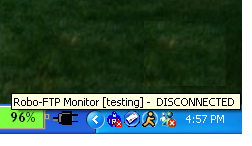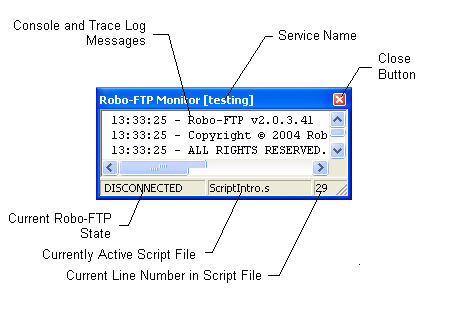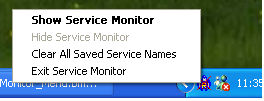The Monitor utility (SrvMonitor.exe) is a Windows desktop tray applet provided with Robo-FTP. This applet monitors the operation of Robo-FTP when it is being run as a Windows service (which normally has no interaction with a user desktop) or when it is being run minimized or otherwise hidden from view. Unlike the Enterprise Dashboard, this utility is available at all license levels.
Monitor provides the following real-time information for a user interested in what Robo-FTP is doing:
| Ø | Current state (e.g., idle, sending a file) |
| Ø | Currently active script file |
| Ø | Current line number of the active script |
| Ø | Scrolling messages issued by Robo-FTP to the unseen console and trace windows |
Monitor identifies an instance of Robo-FTP by a unique character string identifier known as a Service Name. Robo-FTP is given a service name in one of three ways:
| 1. | Via the Service Name field in the Service Installer when Robo-FTP is launched as a Windows service. This is done automatically. |
| 2. | Via the -t command line switch added manually to the shortcut that launches Robo-FTP. See Command Line Switches. |
| 3. | Via the SRVNAME script command when neither (1) nor (2) have been done. The SRVNAME command also allows monitoring to be turned on and off under script control. |
When Monitor launches, it locates any existing Robo-FTP service name(s). If only one name is found, Monitor immediately associates itself with this instance of Robo-FTP. If more than one name is found, Monitor displays a menu that allows you to choose the association you desire.
Monitor also supports a -t command line switch which you may define in any shortcut that launches Monitor. This permits you to specify a known service name - this is useful if you wish to monitor one of multiple instances of Robo-FTP and suppress the menu where the desired instance must be chosen.
When initially launched, Monitor appears as an icon in the Windows desktop tray. The icon itself conveys the state of Robo-FTP as shown below.
![]()
When you hover the mouse cursor over the icon, you get a little more information as shown below.

When you double click on the icon, Monitor opens into a small window like what is shown below.

Click the close button to return Monitor to its icon state.
In the minimized state, right click on the icon for a control menu. The control menu is shown below and each menu function is described.

Show Service Monitor - Opens the Monitor window (same action as double clicking on the tray icon).
Hide Service Monitor - Closes the Monitor and returns it to its icon state.
Clear All Saved Service Names - Reset Monitor to monitor services with new or different names. This is useful when you have selected “Always monitor the instance with this name” option when first starting Monitor and you wish to now monitor additional services or one with a different name.
Exit Service Monitor - Terminate Monitor.
Related command(s): SRVNAME
See also: Installing Robo-FTP as a Service, Enterprise Dashboard